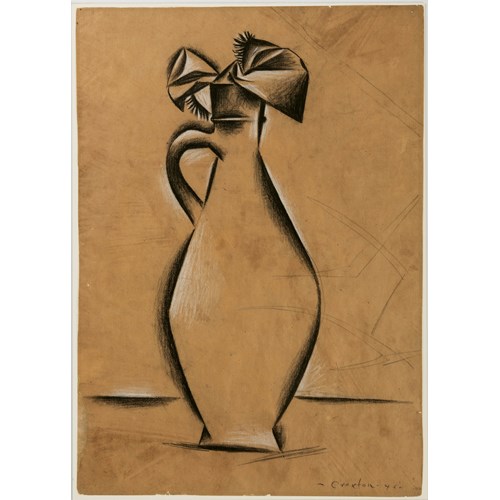Paul Klee
Landscape in the Lower Alps (Voralpine Landschaft)
Medium Oil on paper
Dimension 180 x 280 cm (70⁷/₈ x 110¹/₄ inches)
In the autumn of 1935 Paul Klee began suffering from the debilitating skin disease scleroderma; an autoimmune disorder that left him unable to paint or draw for long periods of time. Although in the course of the following year he made a number of visits to mountain clinics for treatment that helped to alleviate his condition, he was only able to produce a total of twenty-five works during the whole of 1936. By February of 1937, however, Klee’s health had improved to the extent that he was able to work prolifically again, with the result that 1937 and 1938 were among the most productive of the final years of his career; in 1937 he created 264 works, and the following year the number rose to 489. As one scholar has noted of these late paintings and drawings, ‘Klee seems to have derived a paradoxical vitality from the conscious, profound process of coming to terms with disease and the approach of death, a vitality that significantly transformed his art.’ Characterized by a vigour and inventiveness, Klee’s works of the late 1930s also often display his experimentation with various techniques and combinations of oil, chalk and watercolour.
Previously known only from a black-and-white photograph, this vibrant oil sketch on paper of 1937 depicts an Alpine landscape with pine trees, and recalls the time that the artist spent in spas and health clinics in the Swiss mountains during the previous months. Although drawn the same year that Klee was being publicly disparaged in Nazi propaganda, with his work shown at the Entartente Kunst exhibition and his paintings removed from museum collections, the present sheet displays no trace of any reference to this tumultuous period near the end of the artist’s life. Klee’s characteristic serpentine line, dividing the composition and directing the viewer’s eye to the cluster of pine trees at the top, and the use of complimentary pastel colours, serve to highlight the artist’s ever-present imagination and his undying sense of optimism.
The ink drawing of what seems to be a horse or donkey with a disproportionally large head, visible beneath the backing on the verso of this alpine landscape, has remained unpublished until now. It may be likened to a charcoal drawing entitled by the artist Esel, aus der Hand fressend (‘Donkey, Eating out of the Hand’), of the same date and apparently drawn shortly before the present sheet, in the collection of the Zentrum Paul Klee in Bern.
As one modern scholar has written, ‘Klee was a gardener in a little piece of paradise. Under his direction his charges blossomed beautifully, full of harmony and grace. His motifs seem to develop with consummate ease, almost – it would seem – of their own accord, and whatever basic note he strikes, his colours contrast in such a way that their sound blends in inevitable harmony. Even when he compresses his pictorial resources to the utmost, he never slips into anything uncontrolled or random. Klee formulates subtly sensitive offerings for the viewer’s eye, offerings so cautious and gentle that they readily elide consumption in this day and age. Paul Klee’s art demands undivided attention – and it is also capable of opening one’s eyes to something that lies beyond the image itself.’
The present sheet was among several works by Paul Klee sold in New York by the expatriate German art dealers J. B. Neumann and Karl Nierendorf, who from 1938 onwards actively promoted the artist’s work in America. Landscape in the Lower Alps (Voralpine Landschaft) was purchased by Dr. Eric Ponder, a distinguished American haematologist who assembled a small but choice collection of works by Klee.
Medium: Oil on paper
Signature: Faintly signed Klee in brown ink at the lower left.
Dimension: 180 x 280 cm (70⁷/₈ x 110¹/₄ inches)
Provenance: Daniel-Henry Kahnweiler (Galerie Simon), Paris, until 1938
Karl Nierendorf, Cologne, Berlin and New York, from 1938
Israel Ber Neumann, Berlin and New York
Dr. and Mrs. Eric Ponder, Mineola, New York
Acquired from him in 1962 by Galerie Berggruen & Cie, Paris
Acquired from them in 1962 by James Wise, Geneva, New York and Nice
Anonymous sale, Geneva, Galerie Motte, 1 November 1963, lot 119
Anonymous sale, Geneva, Galerie Motte, 5 December 1964, lot 74
Brook Street Gallery, London
Acquired from them in 1966 by a Mr. Yerburgh (according to a label on the backing board)
Private collection
Private collection, England, since 2003.
Literature: Paul Klee, Oeuvre-Katalog, MS., 1937, no.11; Bern, Paul Klee Foundation, Paul Klee. Catalogue Raisonné, Vol.7 1934-1938, 2003, p.219, no.6947 (1937.11), as location unknown; Bern, Zentrum Paul Klee, Jahresbericht 2018, 2019, p.12.
Exhibition: Paris, Galerie Simon, Paul Klee: oeuvres récentes, 1938, no.38; New York, Nierendorf Galleries, Exhibition Paul Klee, November 1938, no.58 (as Alpine Foothills); Geneva, Galerie du Perron, Paul Klee: Exposition, 1965, no.26; London, Brook Street Gallery, Klee, 1966, no.31 (as Alpine Foothills).
More artworks from the Gallery


_T638203653817250220.jpg?width=2000&height=2000&mode=max&scale=both&qlt=90)






